Evaluation and Influencing Factors of Coupling Coordination of “Production–Living–Ecological” Functions Based on Grid Scale: Empirical Experience of Karst Beibu Gulf in Southwest Guangxi, China
Abstract
1. Introduction
- (1)
- Evaluate PLEFs from the grid scale and summarize the temporal and spatial evolution characteristics of PLEFs;
- (2)
- Introduce the Coupling Coordination Degree (CCD) model to measure the spatial and temporal changes in PLEFs coordination status;
- (3)
- Integrated Geodetector and Geographically and Temporally Weighted Regression (GTWR) models to reveal the impact mechanism of the PLEFs relationship in TS.
2. Study Area and Data Sources
2.1. Study Area
2.2. Data Sources
3. Research Framework and Methods
3.1. Research Framework
3.2. Research Method
3.2.1. Classification of TS and Its PLEFs Evaluation
3.2.2. Land Use Transfer Matrix
3.2.3. Revealed Comparative Advantage Index
3.2.4. Coupling Coordination Degree Model
3.2.5. Geodetector
3.2.6. Geographically and Temporally Weighted Regression
4. Results and Analysis
4.1. Analysis of Spatio-Temporal Variation Characteristics of PLES in TS
4.2. Analysis of Spatio-Temporal Variation Characteristics of PLEFs in TS
4.2.1. Evaluation Results of PLEFs in TS
4.2.2. Spatio-Temporal Variation Dominated by PLEFs in TS
4.2.3. Spatio-Temporal Variation in PLEFs Combinatorial Type in TS
4.3. Evaluation of Coupling and Coordination Among PLEFs in TS
4.4. Influencing Factors of Coupled Coordination Relationships of PLEFs in TS
4.5. Spatial-Temporal Heterogeneity of Factors Influencing the Coupled Coordination Relationship of PLEFs in TS
5. Discussion
5.1. Mechanisms Affecting the Coupled Coordination Relationship of PLEFs in TS
5.2. Contributions and Limitations
6. Conclusions
- (1)
- The territorial space of the region is primarily ecological space, followed by production space, with living space being the smallest; under the primary classification, production and ecological spaces predominantly flow into living space; under the secondary classification, there is a significant conversion between agricultural production space and forest and grassland ecological space, which also flows into rural living space.
- (2)
- The spatial pattern of PLEFs in TS is relatively stable: Ecological function is generally high and evenly distributed. Production function tends to cluster in urban areas, with low levels in the west. Living function shows the most significant spatial differences, clustering in the central capital city. The regional grids can be divided into three types based on functional dominance and six types based on functional combination.
- (3)
- The coupling and coordination of the Production–Living–Ecological function is mainly moderately disordered. Living function is seriously disordered with production and ecological function. The production–ecological function is mainly moderately coordination.
- (4)
- Ecological protection has a significant impact on the coupling coordination degree of PLEFs compared to other factors, while the influence of public facilities, industrial development, and cultivated land protection continues to strengthen, the effect of population density gradually weakens. The interaction between ecological protection and other factors significantly increased from 2010 to 2015. In 2020, the interaction between cultivated land protection and other factors significantly increased.
Author Contributions
Funding
Data Availability Statement
Acknowledgments
Conflicts of Interest
Abbreviations
| TS | Territorial Space |
| PLES | Production–Living–Ecological Space |
| PLEFs | Production–Living–Ecological Fuctions |
| P-L-E | Production–Living–Ecology |
| P-L | Production–living |
| P-E | Production–Ecology |
| L-E | Living–Ecology |
| VIF | Variance Inflation Factor |
| OLS | Ordinary Least Squares |
| GWR | Geographically Weighted Regression |
| GTWR | Geographical and Temporal Weighted Regression |
| CCD | Coupling Coordination Degree |
| PCA | Principal Component Analysis |
| BGEZ | Beibu Gulf Economic Zone |
| GIS | Geographic Information System |
| ASEAN | Association of Southeast Asian Nations |
| NDVI | Normalized Difference Vegetation Index |
| POI | Point of Interest |
References
- Wang, Q.; Chen, T.; Li, A.; Zhang, S.; Wang, Y. Evaluation of Territorial Utilization Quality Based on “Production-Living-Ecological” Perspectives-A Case Study of Panxi Region. Mt. Res. 2020, 38, 290–302. [Google Scholar]
- Huang, J.; Lin, H.; Qi, X. A literature review on optimization of spatial development pattern based on ecological-production-living space. Prog. Geogr. 2017, 36, 378–391. [Google Scholar]
- Ding, Z.; Tian, P.; Tang, Y. Terrain Gradient Effect on Land Spatial Function Changes in Typical Mountainous and Hilly Areas. Res. Soil Water Conserv. 2023, 30, 379–386. [Google Scholar]
- Wang, Y.; Zhao, R.; Li, Y.; Yao, R.; Wu, R.; Li, W. Research on the evolution and the driving forces of land use classification for production, living, and ecological space in China’s Qilian Mountains Nature Reserve from 2000 to 2020. Environ. Sci. Pollut. Res. 2023, 30, 64949–64970. [Google Scholar] [CrossRef] [PubMed]
- Song, W.; Cao, S.; Du, M.; He, Z. Aligning territorial spatial planning with sustainable development goals: A comprehensive analysis of production, living, and ecological spaces in China. Ecol. Indic. 2024, 160, 111816. [Google Scholar] [CrossRef]
- Zhu, Z.; Peng, S.; Ma, X.; Lin, Z.; Ma, D.; Shi, S.; Gong, L.; Huang, B. Identification of potential conflicts in the production-living-ecological spaces of the Central Yunnan Urban Agglomeration from a multi-scale perspective. Ecol. Indic. 2024, 165, 112206. [Google Scholar] [CrossRef]
- Yang, T.; Yang, D.; Sun, J.; Luo, J.; Cui, J.; Kong, X. Spatio-temporal evolution and driving mechanism of production, living and ecological function in karst mountainous areas: A case study of Guizhou Province. Ecol. Sci. 2023, 42, 215–224. [Google Scholar]
- Qu, Y.; Wang, S.; Tian, Y.; Jiang, G.; Zhou, T.; Meng, L. Territorial spatial planning for regional high-quality development-An analytical framework for the identification, mediation and transmission of potential land utilization conflicts in the Yellow River Delta. Land Use Policy 2023, 125, 106462. [Google Scholar]
- Li, J.; Sun, W.; Li, M.; Meng, L. Coupling coordination degree of production, living and ecological spaces and its influencing factors in the Yellow River Basin. J. Clean. Prod. 2021, 298, 126803. [Google Scholar] [CrossRef]
- Fang, Y.; Liu, B.; Liu, J. Territorial types and optimization strategies of agriculture multifunctions: A case study of Jilin Province. Prog. Geogr. 2019, 38, 1349–1360. [Google Scholar] [CrossRef]
- SchoBer, B.; Helming, K.; Wiggering, H. Assessing land use changeimpacts: A comparison of the SENSOR land use function approach with other frameworks. J. Land Use Sci. 2010, 5, 159–178. [Google Scholar]
- Reidsma, P.; König, H.; Feng, S.; Bezlepkina, I.; Nesheim, I.; Bonin, M.; Sghaier, M.; Purushothaman, S.; Sieber, S.; Van Ittersum, M.K.; et al. Methods and tools for integrated assessment of land use policies on sustainable development in developing countries. Land Use Policy 2011, 28, 604–617. [Google Scholar] [CrossRef]
- Deng, Y.; Yang, R. Influence Mechanism of Production-Living-Ecological Space Changes in the Urbanization Process of Guangdong Province, China. Land 2021, 10, 1357. [Google Scholar] [CrossRef]
- Zhang, X.; Xu, Z. Functional Coupling Degree and Human Activity Intensity of Production-Living-Ecological Space in Underdeveloped Regions in China: Case Study of Guizhou Province. Land 2021, 10, 56. [Google Scholar] [CrossRef]
- Liu, Y.; Xu, R.; Yang, J.; Xie, X.; Cui, X. Decoding Land Use Conflicts: Spatiotemporal Analysis and Constraint Diagnosis from the Perspectives of Production–Living–Ecological Functions. Land 2024, 13, 2187. [Google Scholar] [CrossRef]
- Lei, W.; Gu, J.; Xie, H. Land use pattern and multifunctional evolution in Hunan Province using “production-living-ecosystem” space. Trans. CSAE 2024, 40, 283–293. [Google Scholar]
- Hong, T.; Liang, N.; Li, H. Study on the Spatial and Temporal Evolution Characteristics and Driving Factors of the “Production–Living–Ecological Space” in Changfeng County. Sustainability 2023, 15, 10445. [Google Scholar] [CrossRef]
- Gong, Z.; Yuan, Y.; Qie, L.; Huang, S.; Xie, X.; Zhong, R.; Pu, L. Spatiotemporal Differentiation and Coupling Coordination Relationship of the Production–Living–Ecological Function at County Scale: A Case Study of Jiangsu Province. Land 2023, 12, 2027. [Google Scholar] [CrossRef]
- Yuan, W.; Bai, L.; Gao, X.; Zhou, K.; Gao, Y.; Zhou, X.; Qiu, Z.; Kou, Y.; Lv, Z.; Zhao, D.; et al. The Ecological Risks in Arid Zones from a Production-Living-Ecological Space Perspective: A Case Study of the Tuha Region in Xinjiang, China. Remote Sens. 2024, 16, 3224. [Google Scholar] [CrossRef]
- Zhou, D.; Xu, J.; Lin, Z. Conflict or coordination? Assessing land use multi-functionalization using production-living-ecology analysis. Sci. Total Environ. 2017, 577, 136–147. [Google Scholar] [CrossRef]
- Zou, L.; Liu, Y.; Yang, J.; Yang, S.; Hu, Y. Quantitative identification and spatial analysis of land use ecological-production-living functions in rural areas on China’s southeast coast. Habitat Int. 2020, 100, 102182. [Google Scholar] [CrossRef]
- Xu, L.; Wang, J.; Zhang, G.; Ma, L. Functional evolution characteristics and zoning control of the “Production-Living-Ecological” function in of the region around Beijing and Tianjin. Urban Probl. 2022, 10, 35–44. [Google Scholar]
- Shan, W.; Jin, X.; Ran, N.; Fan, Y.; Liu, J.; Zhou, Y. “Production-Living-Ecological” Function Evaluation and Coupling Coordination Analysis of Land Use in Jiangsu Province. Resour. Environ. Yangtze Basin 2019, 28, 1541–1551. [Google Scholar]
- Jia, K.; Yu, Y.; Chen, G.; Tang, L.; Yuan, Y. Optimization of territorial spatial pattern in the Hohhot-Baotou-Ordos-Wulanchabu integrated development area based on the “production-living-ecology” functions. J. Arid Land Resour. Environ. 2024, 38, 169–178. [Google Scholar]
- Zhao, H.; Gu, T.; Sun, D.; Miao, C. Dynamic evolution and influencing mechanism of urban human settlements in the Yellow River Basin from the perspective of “production-living-ecological” function. Acta Geogr. Sin. 2023, 78, 2973–2999. [Google Scholar]
- Lin, S.; Lu, R.; Ye, Z.; Liu, S. Spatial Evolution and Coupling Coordination of Territorial Space Functions in China–Vietnam Border Area. China Land Sci. 2022, 36, 90–101. [Google Scholar]
- Tian, C.; Cheng, L.; Yin, T. One village, one strategy: Set priorities for the construction of rural production-living-ecological function and improvement of human settlement environment quality. Chin. J. Agric. Resour. Reg. Plan. 2022, 43, 201–209. [Google Scholar]
- Zhang, L.; Ji, X.; Su, Y.; Lu, Z. Spatial–Temporal Evolution and Coupling and Coordination of “Production-Life-Ecological” in Energy-Rich Area: A Perspective on Structure and Function. Land 2025, 14, 520. [Google Scholar] [CrossRef]
- Dou, Y.; Ye, W.; Li, B.; Liu, P. Tourism Adaptability of Traditional Village Based on Living-Production-Ecological Spaces: A Case Study of Zhangguying Village. Econ. Geogr. 2022, 42, 215–224. [Google Scholar]
- Wang, F.; Dong, Y. Dynamic evaluation of land use functions based on grey relation projection method and diagnosis of its obstacle indicators: A case study of Guangzhou city. J. Nat. Resour. 2015, 30, 1698–1713. [Google Scholar]
- Lu, Z.; Zhang, M.; Hu, C.; Ma, L.; Chen, E.; Zhang, C.; Xia, G. Spatiotemporal Changes and Influencing Factors of the Coupled Production–Living–Ecological Functions in the Yellow River Basin, China. Land 2024, 13, 1909. [Google Scholar] [CrossRef]
- Xu, J.; Tong, Z.; Liu, X.; Zhang, J. Evaluation of Ecological Carrying Capacity in Western Jilin Province from the Perspective of “Production–Living–Ecological Spaces” Coupling Coordination. Sustainability 2025, 17, 211. [Google Scholar] [CrossRef]
- Yin, J.; Song, C.; Shi, P.; Gao, P.; Zhang, X. Spatial and temporal transition characteristics and influencing factors of “production-living-ecological” functions of rural areas at county level in Gansu province from the perspective of coupling. Geogr. Res. 2024, 43, 874–892. [Google Scholar]
- Wang, Y.; Wang, Y.; Xu, W.; Sheng, Z.; Zhu, Z.; Tang, H. Eco-environmental effect and driving factors of changing “production-living-ecological space” in northern Xinjiang, China. Front. Ecol. Evol. 2023, 11, 1248702. [Google Scholar] [CrossRef]
- Yu, T.; Huang, X.; Cui, X. From pixels to Policy: Unveiling the interplay of Production, Living, and ecological functions in Nanjing metropolitan area. Ecol. Indic. 2024, 166, 112443. [Google Scholar] [CrossRef]
- Hou, Y.; Zhang, Z.; Wang, Y.; Sun, H.; Xu, C. Function Evaluation and Coordination Analysis of Production-Living-Ecological Space Based on the Perspective of Type-Intensity-Connection: A Case Study of Suzhou, China. Land 2022, 11, 1954. [Google Scholar] [CrossRef]
- Duan, Y.; Wang, H.; Huang, A.; Xu, Y.; Lu, L.; Ji, Z. Identification and spatial-temporal evolution of rural “production-living-ecological” space from the perspective of villagers’ behavior: A case study of Ertai Town, Zhangjiakou City. Land Use Policy 2021, 106, 105457. [Google Scholar] [CrossRef]
- Huang, A.; Wang, Y.; Xiang, Y.; Xu, X.; Li, T.; Zhou, G.; Yuan, Z.; Zhu, L. A comprehensive framework for assessing spatial conflicts risk: A case study of production-living-ecological spaces based on social-ecological system framework. Habitat Int. 2024, 154, 103218. [Google Scholar] [CrossRef]
- Qu, Y.; Dong, X.; Su, D.; Guang, H.; Ma, W. How to balance protection and development? A comprehensive analysis framework for territorial space utilization scale, function and pattern. J. Environ. Manag. 2023, 339, 117809. [Google Scholar] [CrossRef]
- Yang, Y.; Ren, X.; Yan, J. Trade-offs or synergies? Identifying dynamic land use functions and their interrelations at the grid scale in urban agglomeration. Cities 2023, 140, 104384. [Google Scholar] [CrossRef]
- Kang, Q.; Guo, Q.; Ding, Y.; Zhang, Y. Tradeoffs/synergies analysis of “Production-Living-Ecological” functions in Shanxi province. J. Nat. Resour. 2021, 36, 1195–1207. [Google Scholar] [CrossRef]
- Li, W.; Zeng, Y.; Peng, Y.; Chen, W.; Dong, Y.; Ye, Z.; Chen, Y. Spatiotemporal Variation and Driving Mechanisms of the Global ProductionLiving-Ecological Space Coupling Coordination Degree. Land 2024, 13, 2136. [Google Scholar] [CrossRef]
- Shan, Y.; Wei, S.; Yuan, W.; Miao, Y. Spatial-temporal differentiation and influencing factors of coupling coordination of “production-living-ecological” functions in Yangtze River Delta urban agglomeration. Acta Geogr. Sin. 2022, 42, 6644–6655. [Google Scholar]
- Li, Y.; Zhang, S.; Zhao, J.; Zhang, G.; Qu, G.; Ma, S.; Liu, X. Spatiotemporal evolution and Sustainably comprehensive zoning optimization of production-living-ecological functions in the Mountain-Flatland areas. Heliyon 2024, 10, e23425. [Google Scholar] [CrossRef]
- Wang, Y. Spatial–temporal evolution of “Production-Living-Ecologica” function and layout optimization Strategy in China: A case study of Liaoning Province, China. Environ. Sci. Pollut. Res. 2023, 30, 10683–10696. [Google Scholar] [CrossRef] [PubMed]
- Li, Z.; Li, Y.; Wang, L.; Pei, Y. Study on the Functional Characteristics and Division Optimization of “Production-Living-Ecological” of Geographical Space in Yunnan Province. Ecol. Econ. 2021, 37, 94–101. [Google Scholar]
- Ling, Z.; Li, Y.; Jiang, W.; Liao, C.; Ling, Y. Dynamic Change Characteristics of “Production-living-ecological Spaces” of Urban Agglomeration Interlaced with Mountains, Rivers and Sea: A Case Study of the Beibu Gulf Urban Agglomeration in Guangxi. Econ. Geogr. 2022, 42, 18–24. [Google Scholar]
- Feng, T.; Yu, X.; Dong, R.; Zhang, F.; Li, C. Spatial-temporal evolution and influencing factors of the coordination degree of “production-living-ecological” functions in Guangxi Beibu Gulf Economic Zone from the coupling perspective. J. China Agric. Univ. 2024, 29, 303–316. [Google Scholar]
- Wang, P.; Pu, X.; Yang, P.; Luo, C. Identification and Spatial-Temporal Evolution Analysis of “Production-Living-Ecological” Space in Karst Area-A Case Study of Huaxi District, Guiyang City. J. Northwest For. Univ. 2023, 38, 263–274. [Google Scholar]
- Gao, Y.; Bai, L.; Zhou, K.; Kou, Y.; Yuan, W.; Zhou, X.; Qiu, Z.; Zhao, D.; Lv, Z.; Wu, Q.; et al. Study on the Coupling Coordination Degree and Driving Mechanism of “Production-Living-Ecological” Space in Ecologically Fragile Areas: A Case Study of the Turpan-Hami Basin. Sustainability 2024, 16, 9054. [Google Scholar] [CrossRef]
- Zhao, J.; Zhao, Y. Synergy/trade-offs and differential optimization of production, living, and ecological functions in the Yangtze River economic Belt, China. Ecol. Indic. 2023, 147, 109925. [Google Scholar] [CrossRef]
- Zhou, H.; Wu, X.; Nie, H.; Wang, X.; Zang, S. Coupling coordination analysis and obstacle factors identification of rural living-production-ecological functions in a farming-pastoral ecotone. Ecol. Indic. 2024, 158, 111398. [Google Scholar] [CrossRef]
- Liang, H.; Li, J.; Yin, S.; Feng, L.; Shao, J.; Li, S. Spatial-temporal evolution and influencing factors analysis of coupling coordination of “production-living-ecological” functions in central-southern Liaoning and Harbin-Changchun urban agglomeration. J. China Agric. Univ. 2023, 28, 218–233. [Google Scholar]
- Kang, Q.; Guo, Q.; Ding, Y.; Zhang, Y.; Hu, Y.; Chen, S. Temporal and Spatial Evolution and Driving Factors of Productional-Living-Ecological Functions of Shanxi Province during 2005–2018. Bull. Soil Water Conserv. 2021, 41, 327–337. [Google Scholar]
- Jiao, G.; Yang, X.; Huang, Z.; Zhang, X.; Lu, L. Evolution characteristics and possible impact factors for the changing pattern and function of “Production-Living-Ecological” space in Wuyuan county. J. Nat. Resour. 2021, 36, 1252–1267. [Google Scholar] [CrossRef]
- Feng, T.; Yu, X.; Zhou, Y.; Dong, R.; Wu, D.; Zhang, M. Research on the Coordination Relationship and Zoning Optimization of Territorial Spatial Functions in Southern Karst Regions Based on a Multi-Scale Fusion Model. Land 2025, 14, 430. [Google Scholar] [CrossRef]
- Xie, X.; Li, X. Spatio-temporal evolution characteristics and influencing factors of “production-living-ecological” functions in Henan Province, China. Trans. CSAE 2021, 37, 243–252. [Google Scholar]
- Lin, S.; Lu, R.; Liu, S.; Ye, Z.; Wei, Q.; Luo, J. Land use pattern and multifunctional evolution in the border areas in the Guangxi Zhuang Autonomous Region based on “production-living-ecosystem” space. Trans. CSAE 2021, 37, 265–274. [Google Scholar]
- Pang, L.; Zhou, X.; Wei, L. Function evaluation and coupling coordination analysis of “productive-living-ecological” land space in Guangxi Zhuang Autonomous Region during 2009–2018. Bull. Soil Water Conserv. 2021, 41, 237–244. [Google Scholar]
- Zhao, R.; Xiong, K.; Lan, A.; Chen, Q.; Liu, Z.; Feng, F.; Yu, N. Changes in Ecological-Production-Social Functions in Karst Areas: Insight from Guizhou Province, South China Karst. Land 2025, 14, 209. [Google Scholar] [CrossRef]
- Jiang, H.; Cui, Z.; Fan, T.; Hua, Y. Impacts of land use change on carbon storage in the Guangxi Beibu Gulf Economic Zone based on the PLUS-InVEST model. Sci. Rep. 2025, 15, 6468. [Google Scholar] [CrossRef] [PubMed]
- Gao, C.; Hu, B.; Wang, Z.; Huang, S.; Zhang, L. Study on spatiotemporal changes of ecosystem service trade-offs/synergies and driving mechanisms in the key zone of mountain-river-sea coupling: A case study of the southwest Guangxi Karst-Beibu Gulf. Ecol. Indic. 2024, 169, 112892. [Google Scholar] [CrossRef]
- Kong, D.; Chen, H.; Wu, K. The evolution of “Production-Living-Ecological” space, eco-environmental effects and its influencing factors in China. J. Nat. Resour. 2021, 36, 1116–1135. [Google Scholar] [CrossRef]
- Zhang, L.; Hu, B.; Zhang, Z.; Liang, G. Research on the spatiotemporal evolution and mechanism of ecosystem service value in the mountain-river-sea transition zone based on “production-living-ecological space”-Taking the Karst-Beibu Gulf in Southwest Guangxi, China as an example. Ecol. Indic. 2023, 148, 109889. [Google Scholar] [CrossRef]
- Li, W.; Cai, Z.; Jin, L. Spatiotemporal characteristics and influencing factors of the coupling coordinated development of production-living-ecology system in China. Ecol. Indic. 2022, 145, 109738. [Google Scholar] [CrossRef]


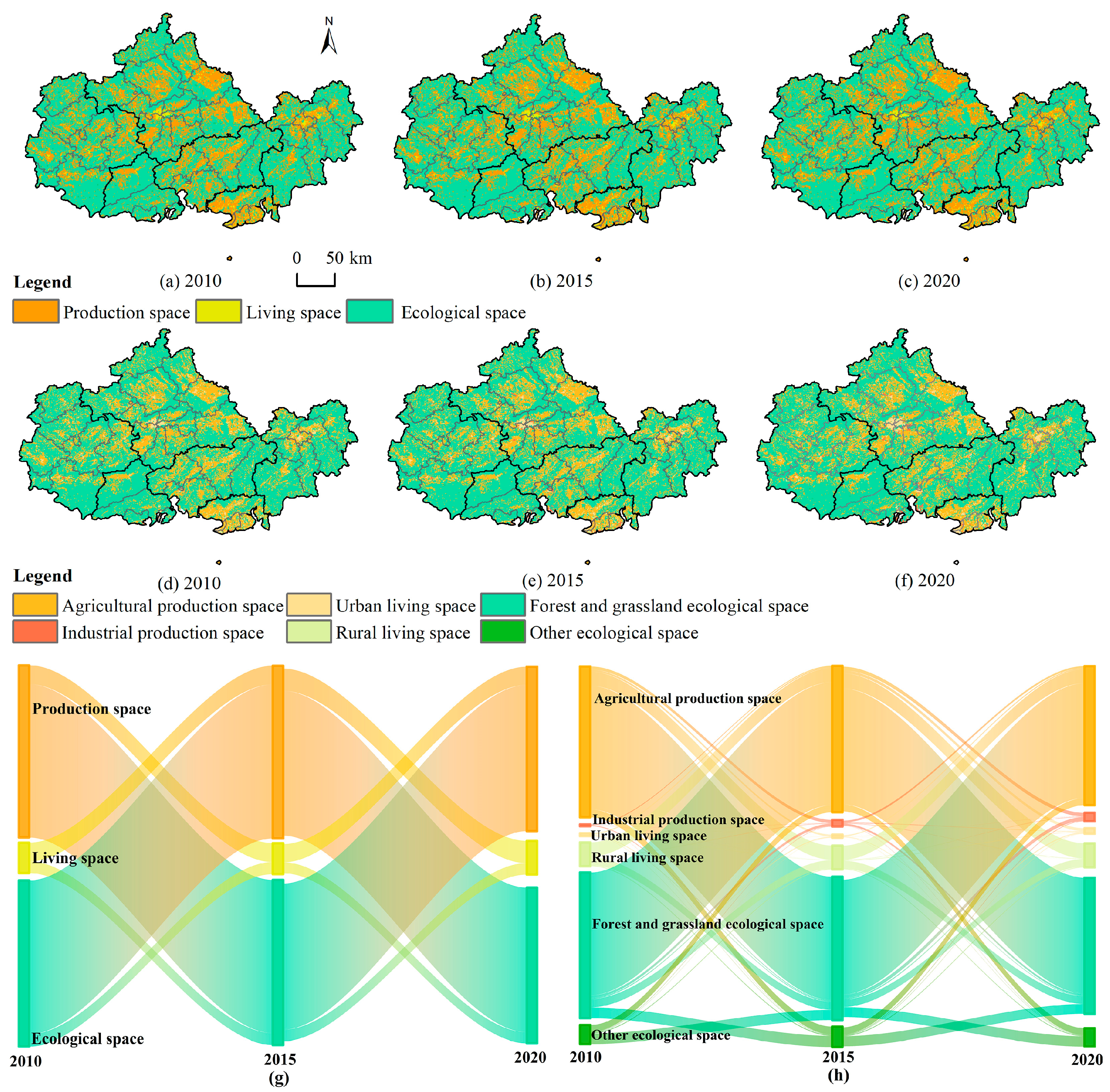
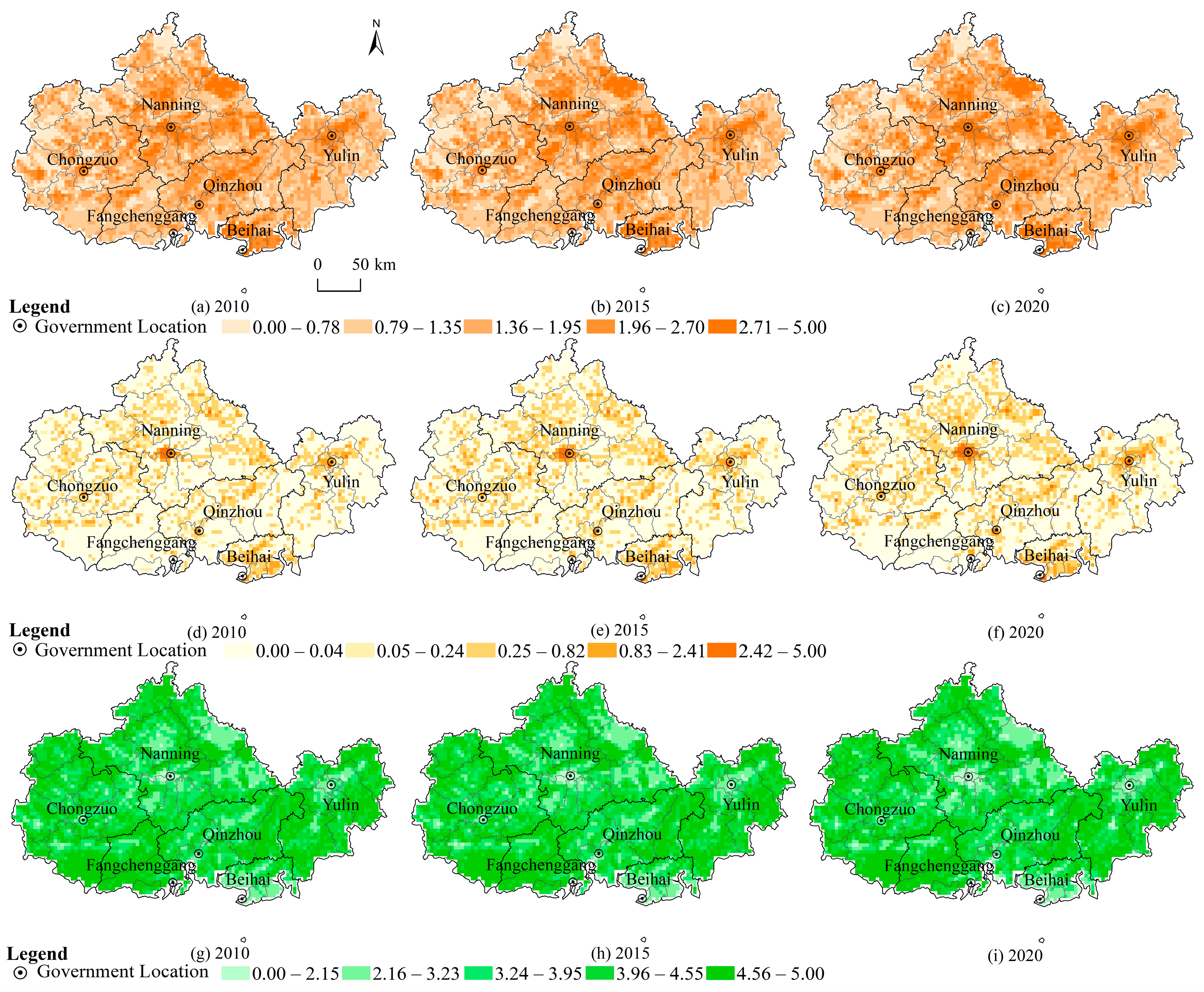


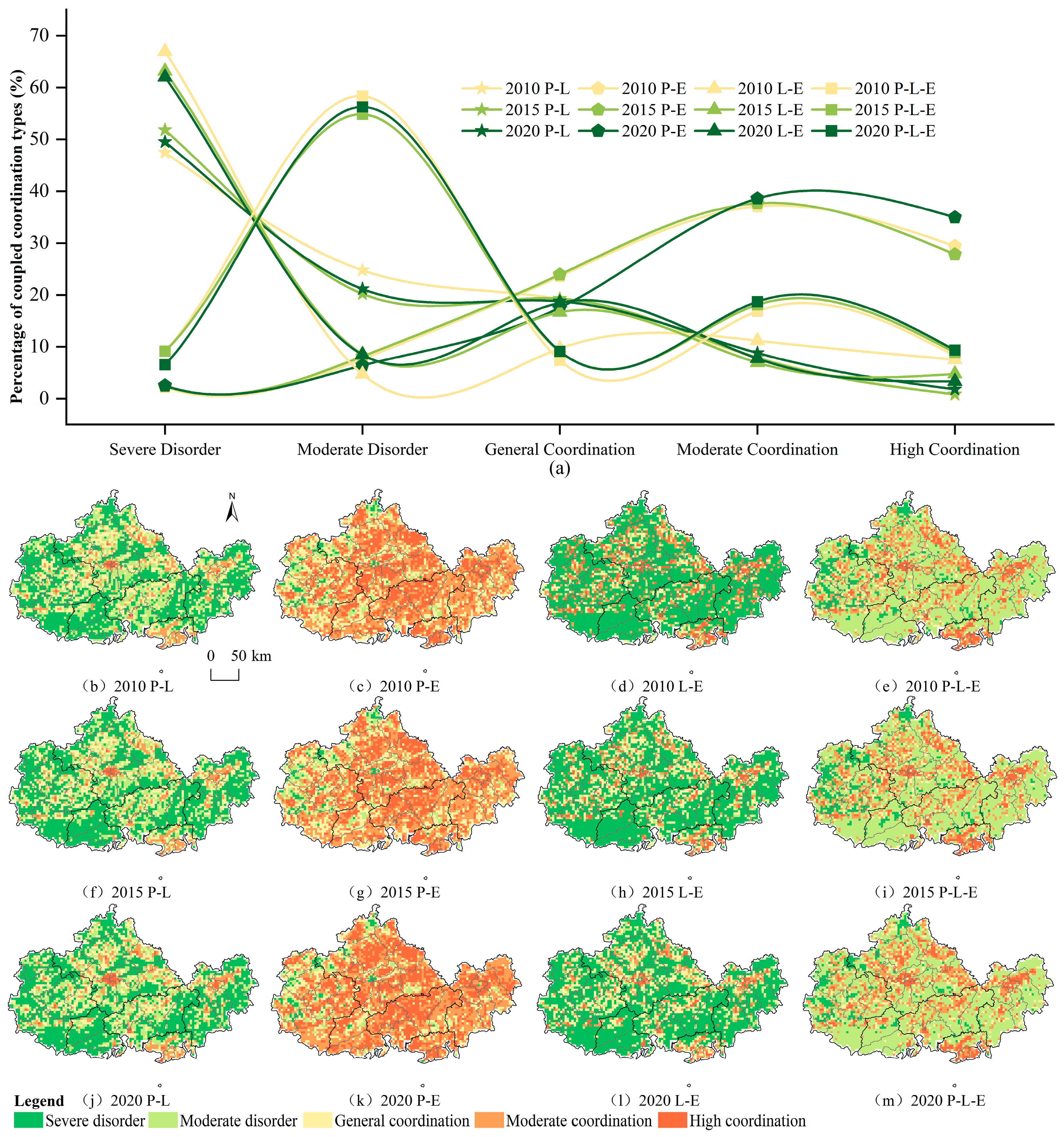
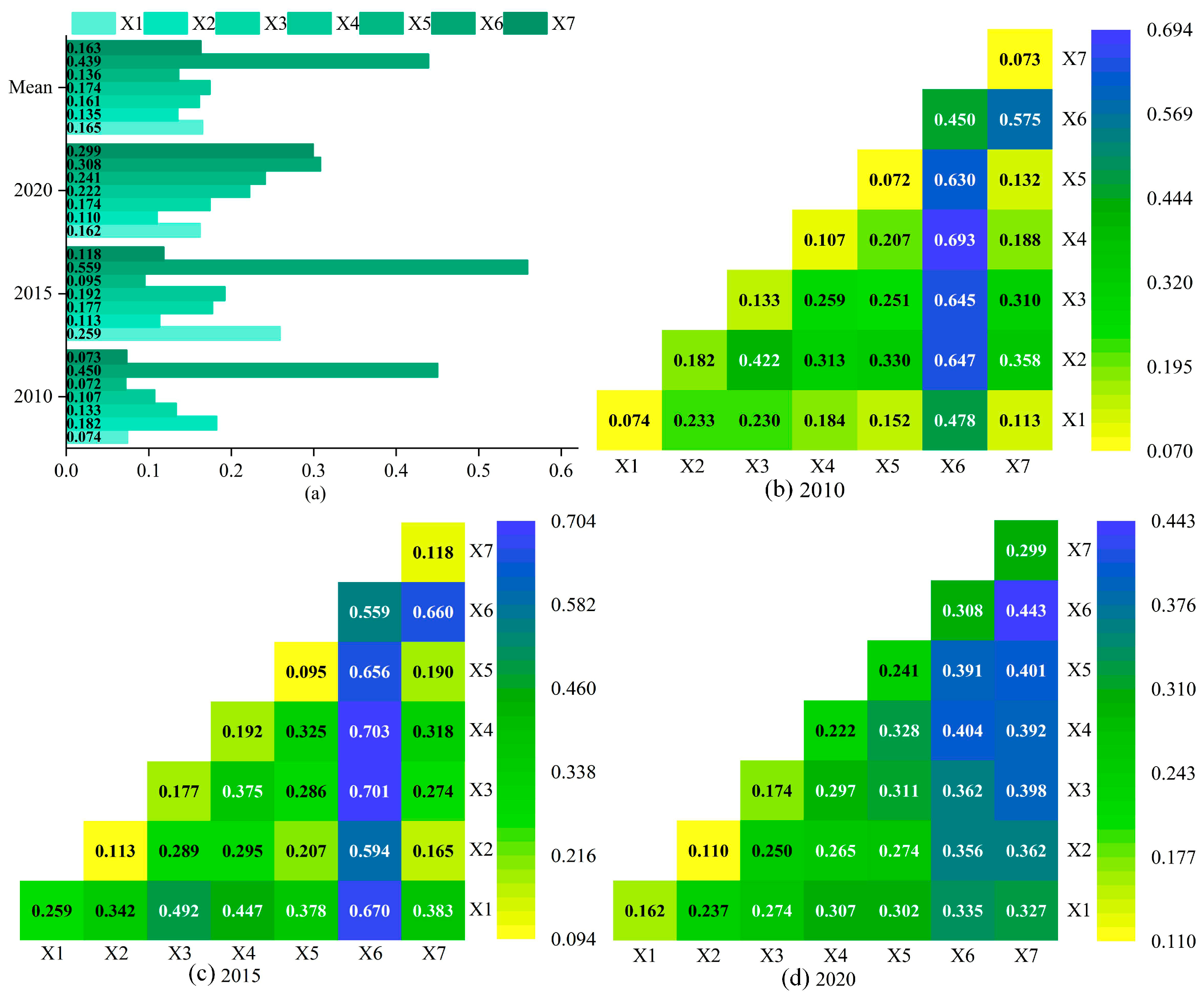

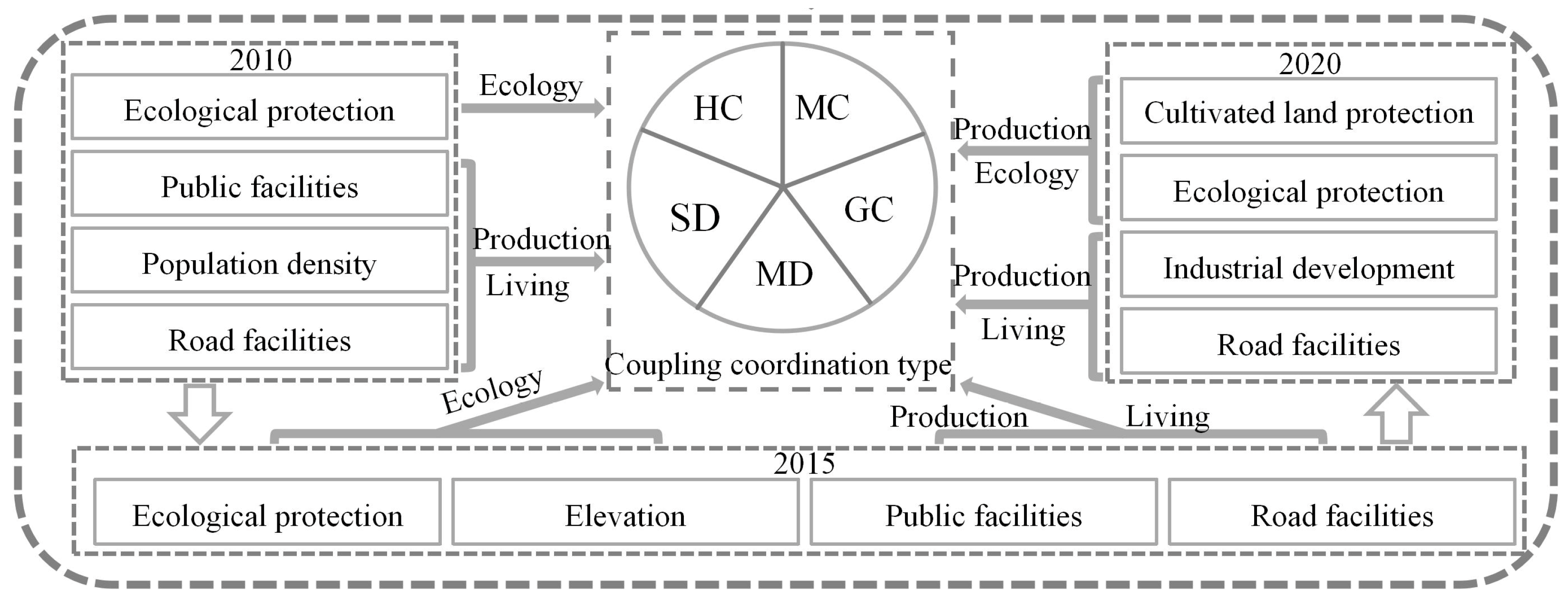
| Data Attribute | Index | Original Resolution | Date | Data Sources |
|---|---|---|---|---|
| Raster data | Land use/cover | 1 km | 2010–2020 | https://www.resdc.cn/ (accessed on 10 September 2024) |
| Population density | 1 km | 2010–2020 | https://www.resdc.cn/ (accessed on 10 September 2024) | |
| GDP density | 1 km | 2010–2020 | https://www.resdc.cn/ (accessed on 10 September 2024) | |
| NDVI | 1 km | 2010–2020 | https://www.resdc.cn/ (accessed on 10 September 2024) | |
| DEM | 1 km | 2020 | https://www.resdc.cn/ (accessed on 10 September 2024) | |
| Vector data | Road data | / | 2010–2020 | https://www.openstreetmap.org/ (accessed on 10 September 2024) |
| POI data | / | 2010–2020 | https://lbs.amap.com/ (accessed on 10 September 2024) |
| Primary Classification | Secondary Classification | Land Use Types |
|---|---|---|
| Production space | Agricultural production space | Paddy fields, dry land |
| Industrial production space | Industrial, mining and other construction land | |
| Living space | Urban living space | Urban land |
| Rural living space | Rural settlements | |
| Ecological space | Forest and grass ecological space | Woodland, shrubbery, sparse woodland, other woodland, high coverage grassland, medium coverage grassland, low coverage grassland |
| Other ecological space | Rivers, lakes, reservoirs, ponds, permanent glaciers and snow, beach, shoaly land, sand land, gobi, saline–alkali land, swamps, bare land, bare rock texture, other |
| Primary Classification | Secondary Classification | Production Function | Living Function | Ecological Function |
|---|---|---|---|---|
| Cultivated land | Paddy field | 3 | 0 | 3 |
| Dry land | 3 | 0 | 3 | |
| Forest land | Woodland | 1 | 0 | 5 |
| shrubbery | 0 | 0 | 5 | |
| Sparse woodland | 0 | 0 | 5 | |
| Other woodlands | 0 | 0 | 5 | |
| Grass land | High coverage grassland | 3 | 0 | 5 |
| Medium coverage grassland | 1 | 0 | 3 | |
| Low coverage grassland | 0 | 0 | 1 | |
| Water | River channel | 1 | 0 | 1 |
| Reservoir pond | 1 | 0 | 1 | |
| Beach | 0 | 0 | 5 | |
| Shoaly land | 0 | 0 | 5 | |
| Urban and rural areas, industrial and mining, residential land | Urban land | 5 | 5 | 0 |
| Rural settlements | 3 | 5 | 0 | |
| Other construction land | 5 | 1 | 0 | |
| Unused land | Sandy land | 0 | 0 | 1 |
| Saline–alkali land | 0 | 0 | 1 | |
| Marshland | 0 | 0 | 5 | |
| Bare land | 0 | 0 | 1 | |
| Bare rock texture | 0 | 0 | 1 |
| Coordination Category | Characteristic |
|---|---|
| Severe Disorder (SD) | The level of each function is at a low level, and the overall coordination between functions is very poor. |
| Moderate Disorder (MD) | The functional level and coordination have improved but are still poor. |
| General Coordination (GC) | The gap between the functions gradually narrowed, and the mutual restriction between the functions gradually turned into mutual promotion. |
| Moderate Coordination (MC) | There is a positive coordination and promotion effect between the functions, and it gradually presents a common coordinated development. |
| High Coordination (HC) | Each function is at a high level of development, and the coordinated development of functional coupling is also at a high level. |
Disclaimer/Publisher’s Note: The statements, opinions and data contained in all publications are solely those of the individual author(s) and contributor(s) and not of MDPI and/or the editor(s). MDPI and/or the editor(s) disclaim responsibility for any injury to people or property resulting from any ideas, methods, instructions or products referred to in the content. |
© 2025 by the authors. Licensee MDPI, Basel, Switzerland. This article is an open access article distributed under the terms and conditions of the Creative Commons Attribution (CC BY) license (https://creativecommons.org/licenses/by/4.0/).
Share and Cite
Feng, T.; Wu, D.; Yu, X.; Zhang, M.; Dong, R.; Chen, S. Evaluation and Influencing Factors of Coupling Coordination of “Production–Living–Ecological” Functions Based on Grid Scale: Empirical Experience of Karst Beibu Gulf in Southwest Guangxi, China. Land 2025, 14, 614. https://doi.org/10.3390/land14030614
Feng T, Wu D, Yu X, Zhang M, Dong R, Chen S. Evaluation and Influencing Factors of Coupling Coordination of “Production–Living–Ecological” Functions Based on Grid Scale: Empirical Experience of Karst Beibu Gulf in Southwest Guangxi, China. Land. 2025; 14(3):614. https://doi.org/10.3390/land14030614
Chicago/Turabian StyleFeng, Ting, Dong Wu, Xiaodong Yu, Meilin Zhang, Renling Dong, and Sihan Chen. 2025. "Evaluation and Influencing Factors of Coupling Coordination of “Production–Living–Ecological” Functions Based on Grid Scale: Empirical Experience of Karst Beibu Gulf in Southwest Guangxi, China" Land 14, no. 3: 614. https://doi.org/10.3390/land14030614
APA StyleFeng, T., Wu, D., Yu, X., Zhang, M., Dong, R., & Chen, S. (2025). Evaluation and Influencing Factors of Coupling Coordination of “Production–Living–Ecological” Functions Based on Grid Scale: Empirical Experience of Karst Beibu Gulf in Southwest Guangxi, China. Land, 14(3), 614. https://doi.org/10.3390/land14030614








